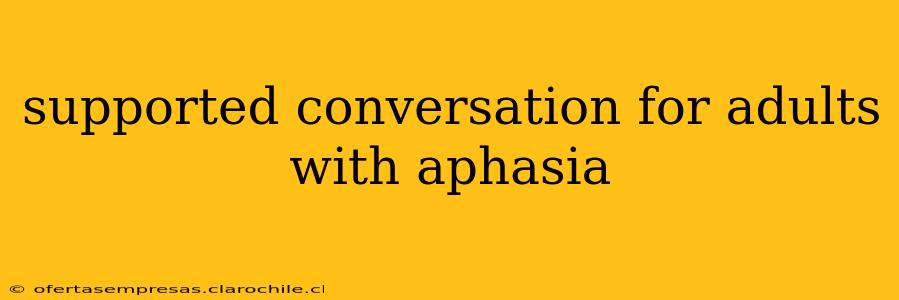Aphasia, a language disorder affecting the ability to communicate, presents unique challenges for adults. Supported conversation strategies are crucial for improving communication and enhancing quality of life. This guide explores various techniques and resources to foster meaningful interactions.
What is Supported Conversation for Adults with Aphasia?
Supported conversation for adults with aphasia (SCA) encompasses a range of techniques designed to facilitate communication between individuals with aphasia and their communication partners. It's not about "fixing" the person with aphasia, but rather creating an environment where effective communication becomes possible. This involves adapting communication styles, utilizing assistive technology, and fostering understanding and patience. The goal is to maximize participation and engagement in everyday conversations.
How Can I Support Someone with Aphasia in Conversation?
Successfully supporting someone with aphasia requires patience, understanding, and a willingness to adapt. Here are some key strategies:
- Active Listening: Pay close attention to both verbal and nonverbal cues. Don't interrupt, and show that you're engaged through eye contact and body language.
- Simple Language: Use shorter sentences and simpler vocabulary. Avoid jargon, idioms, and complex grammatical structures.
- Visual Aids: Pictures, objects, or written words can help clarify meaning and reduce reliance on spoken language alone.
- Patience: Allow extra time for the person with aphasia to formulate their thoughts and respond. Don't rush or pressure them.
- Positive Reinforcement: Encourage and praise their efforts, even if their communication isn't perfect.
- Collaborative Communication: Work together to find ways to communicate effectively. This might involve using gestures, writing, drawing, or assistive technology.
What types of assistive technology can help with aphasia?
Assistive technology plays a vital role in improving communication for individuals with aphasia. These tools can range from simple communication boards to sophisticated speech-generating devices. Some examples include:
- Communication Boards: These boards contain pictures, symbols, or words that individuals can point to or select to express themselves.
- Speech-Generating Devices (SGDs): These devices allow individuals to create and speak messages using synthesized speech. They often have pre-programmed phrases or allow for custom message creation.
- Augmentative and Alternative Communication (AAC) Apps: Numerous apps are available on smartphones and tablets that offer similar functionalities to communication boards and SGDs.
What are some strategies for communicating with someone who has aphasia and is frustrated?
Frustration is a common experience for individuals with aphasia. Addressing frustration requires empathy and understanding:
- Acknowledge their frustration: Let them know you recognize their feelings. A simple "I can see you're frustrated," can make a difference.
- Take a break: If the conversation is becoming too stressful, suggest a break. Returning to the conversation later might be more productive.
- Simplify the conversation: Reduce the complexity of the topic or the amount of information being exchanged.
- Offer alternative communication methods: If speaking is difficult, try using writing, drawing, or a communication board.
- Focus on the message, not the method: The most important thing is to understand the person's intent, regardless of how they communicate it.
What are some conversational strategies that can help maintain a person's self-esteem and dignity?
Maintaining self-esteem is crucial for individuals with aphasia. Here are some strategies to help:
- Treat them as adults: Avoid talking down to them or making assumptions about their abilities.
- Respect their communication attempts: Even if you don't understand everything, acknowledge their efforts and show appreciation for their communication.
- Include them in conversations: Don't exclude them from social situations or discussions just because of their aphasia.
- Focus on their strengths: Highlight their abilities and accomplishments, rather than dwelling on their limitations.
- Provide opportunities for success: Create situations where they can easily participate and feel successful in communication.
What are the best ways to help someone with aphasia feel included in social situations?
Inclusion is paramount for maintaining a person’s social well-being:
- Pre-plan conversations: If possible, discuss the topic beforehand to make sure the individual with aphasia feels prepared.
- Provide clear expectations: Let the individual know what to expect in the social situation, helping them feel more comfortable.
- Use visual supports: Pictures or written words can help individuals understand the social context and follow the conversation.
- Offer opportunities for participation: Find ways for the individual to participate in activities, even if it’s just listening or contributing nonverbally.
- Understand that social fatigue is real: Recognize that participating in social situations can be tiring for individuals with aphasia. Provide breaks when needed.
By implementing these supported conversation strategies, we can create a more inclusive and communicative environment for adults with aphasia, fostering their well-being and enabling them to actively participate in life. Remember, patience, understanding, and collaboration are key to successful communication.
